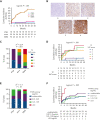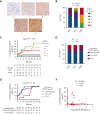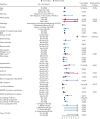Determining venous thromboembolism risk in patients with adult-type diffuse glioma
- PMID: 36399711
- PMCID: PMC10082363
- DOI: 10.1182/blood.2022017858
Determining venous thromboembolism risk in patients with adult-type diffuse glioma
Abstract
Venous thromboembolism (VTE) is a life-threating condition that is common in patients with adult-type diffuse gliomas, yet thromboprophylaxis is controversial because of possible intracerebral hemorrhage. Effective VTE prediction models exist for other cancers, but not glioma. Our objective was to develop a VTE prediction tool to improve glioma patient care, incorporating clinical, blood-based, histologic, and molecular markers. We analyzed preoperative arterial blood, tumor tissue, and clinical-pathologic data (including next-generation sequencing data) from 258 patients with newly diagnosed World Health Organization (WHO) grade 2 to 4 adult-type diffuse gliomas. Forty-six (17.8%) experienced VTE. Tumor expression of tissue factor (TF) and podoplanin (PDPN) each positively correlated with VTE, although only circulating TF and D-dimers, not circulating PDPN, correlated with VTE risk. Gliomas with mutations in isocitrate dehydrogenase 1 (IDH1) or IDH2 (IDHmut) caused fewer VTEs; multivariable analysis suggested that this is due to IDHmut suppression of TF, not PDPN. In a predictive time-to-event model, the following predicted increased VTE risk in newly diagnosed patients with glioma: (1) history of VTE; (2) hypertension; (3) asthma; (4) white blood cell count; (5) WHO tumor grade; (6) patient age; and (7) body mass index. Conversely, IDHmut, hypothyroidism, and MGMT promoter methylation predicted reduced VTE risk. These 10 variables were used to create a web-based VTE prediction tool that was validated in 2 separate cohorts of patients with adult-type diffuse glioma from other institutions. This study extends our understanding of the VTE landscape in these tumors and provides evidence-based guidance for clinicians to mitigate VTE risk in patients with glioma.
© 2023 by The American Society of Hematology.
Conflict of interest statement
Conflict-of-interest disclosure: The authors declare no competing financial interests.
Figures






Comment in
-
Summiting thrombotic hazards in glioma.Blood. 2023 Mar 16;141(11):1245-1246. doi: 10.1182/blood.2022019020. Blood. 2023. PMID: 36929442 No abstract available.
Similar articles
-
Podoplanin Expression and IDH-Wildtype Status Predict Venous Thromboembolism in Patients with High-Grade Gliomas in the Early Postoperative Period.World Neurosurg. 2019 Aug;128:e982-e988. doi: 10.1016/j.wneu.2019.05.049. Epub 2019 May 15. World Neurosurg. 2019. PMID: 31100523
-
Mutant IDH1 and thrombosis in gliomas.Acta Neuropathol. 2016 Dec;132(6):917-930. doi: 10.1007/s00401-016-1620-7. Epub 2016 Sep 23. Acta Neuropathol. 2016. PMID: 27664011 Free PMC article.
-
Risk of Venous Thromboembolism in Grade II-IV Gliomas as a Function of Molecular Subtype.Neurology. 2021 Feb 16;96(7):e1063-e1069. doi: 10.1212/WNL.0000000000011414. Epub 2020 Dec 22. Neurology. 2021. PMID: 33361259 Free PMC article.
-
Isocitrate dehydrogenase mutation and risk of venous thromboembolism in glioma: A systematic review and meta-analysis.Thromb Res. 2022 Nov;219:14-21. doi: 10.1016/j.thromres.2022.08.029. Epub 2022 Sep 6. Thromb Res. 2022. PMID: 36088710
-
Venous Thromboembolism in Brain Tumors: Risk Factors, Molecular Mechanisms, and Clinical Challenges.Semin Thromb Hemost. 2019 Jun;45(4):334-341. doi: 10.1055/s-0039-1688493. Epub 2019 Apr 30. Semin Thromb Hemost. 2019. PMID: 31041803 Free PMC article. Review.
Cited by
-
An MRI Radiomics Approach to Predict the Hypercoagulable Status of Gliomas.Cancers (Basel). 2024 Mar 26;16(7):1289. doi: 10.3390/cancers16071289. Cancers (Basel). 2024. PMID: 38610968 Free PMC article.
-
The risk of venous thromboembolism in adult patients with diffuse glioma: a nationwide population-based study.Acta Oncol. 2024 Nov 14;63:887-892. doi: 10.2340/1651-226X.2024.40137. Acta Oncol. 2024. PMID: 39543846 Free PMC article.
-
Venous Thromboembolism in Patients with Glioblastoma: Molecular Mechanisms and Clinical Implications.Thromb Haemost. 2025 May;125(5):421-434. doi: 10.1055/s-0044-1789592. Epub 2024 Aug 21. Thromb Haemost. 2025. PMID: 39168144 Free PMC article. Review.
-
F3 Expression Drives Sensitivity to the Antibody-Drug Conjugate Tisotumab Vedotin in Glioblastoma.Cancers (Basel). 2025 Feb 27;17(5):834. doi: 10.3390/cancers17050834. Cancers (Basel). 2025. PMID: 40075681 Free PMC article.
-
Epidemiology, biology, and management of venous thromboembolism in gliomas: An interdisciplinary review.Neuro Oncol. 2023 Aug 3;25(8):1381-1394. doi: 10.1093/neuonc/noad059. Neuro Oncol. 2023. PMID: 37100086 Free PMC article.
References
-
- Khorana AA, Francis CW, Culakova E, Kuderer NM, Lyman GH. Thromboembolism is a leading cause of death in cancer patients receiving outpatient chemotherapy. J Thromb Haemost. 2007;5(3):632–634. - PubMed
-
- Marras LC, Geerts WH, Perry JR. The risk of venous thromboembolism is increased throughout the course of malignant glioma: an evidence-based review. Cancer. 2000;89(3):640–646. - PubMed
-
- Lee AY, Levine MN. Venous thromboembolism and cancer: risks and outcomes. Circulation. 2003;107(23 suppl 1):I17–I21. - PubMed
MeSH terms
Substances
Grants and funding
LinkOut - more resources
Full Text Sources
Medical
Research Materials
Miscellaneous

